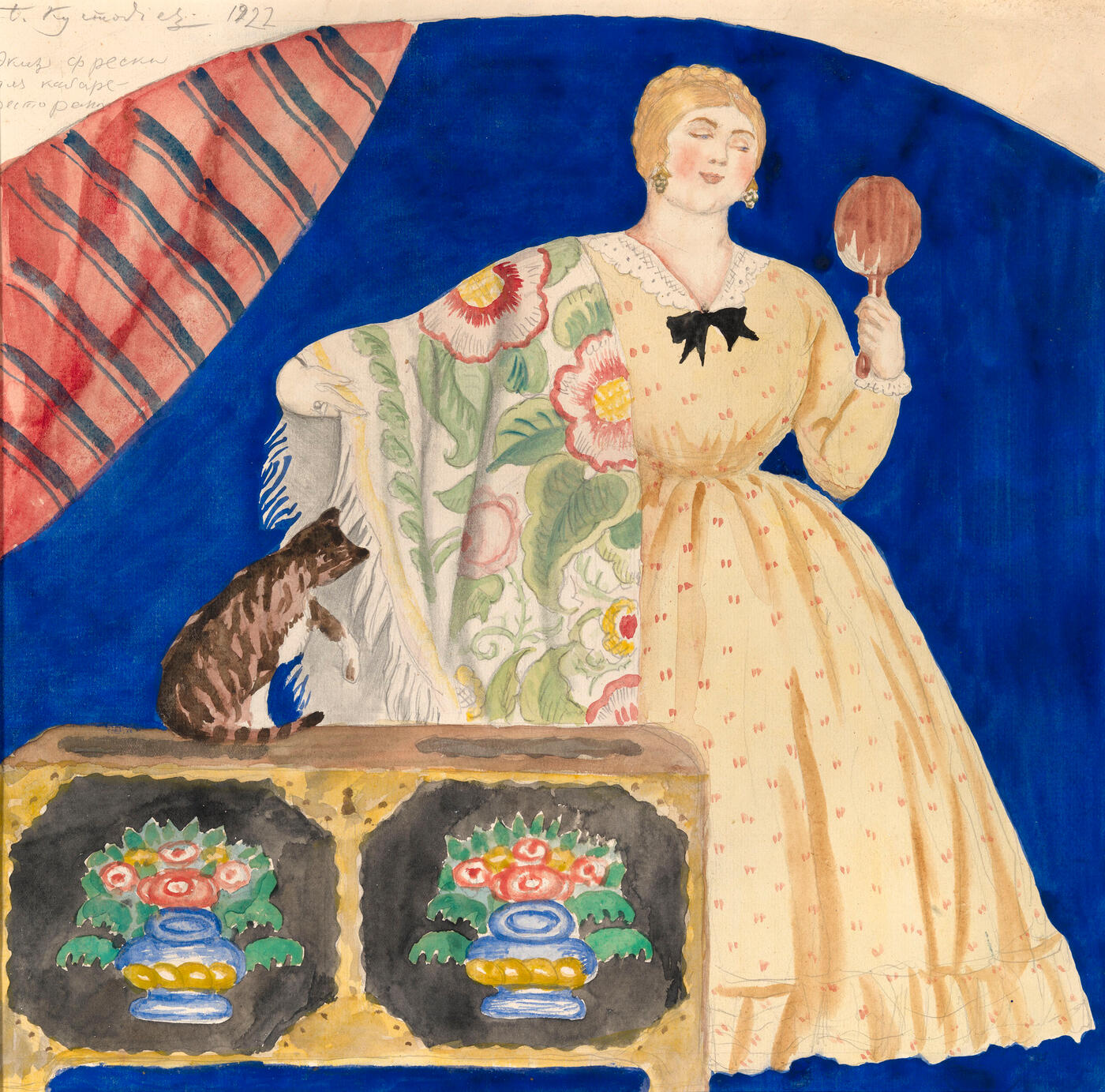25 - 28 November 2012 Russian Art Auctions
25 November 2012

* 7. KUSTODIEV, BORIS (1878–1927)
Merchant's Wife with a Mirror, signed, inscribed in Cyrillic "eskiz freski/dlya kabare-/restorana" and dated 1922.
Pencil, gouache and watercolour on paper, laid on card, 38.5 by 38 cm.
130,000–200,000 GBP
Provenance: Collection of G.L. Kuk, Leningrad, acquired directly from the artist in 1923 (inscribed in Cyrillic on the reverse).
Private collection, Europe.
Authenticity of the work has been confirmed by the expert E. Zhukova.
Exhibited: Posmertnaya vystavka proizvedenii B.M. Kustodieva, The State Russian Museum, Leningrad, 1928, No. 663.
Boris Mikhailovich Kustodiev, The State Russian Museum, Leningrad, 1959 (label on the reverse).
Boris Mikhailovich Kustodiev, Moscow, 1960 (label on the reverse).
Boris Mikhailovich Kustodiev. Vystavka k 100-letiyu so dnya rozhdeniya, Moscow, 1978 (label on the reverse).
Literature: Exhibition catalogue, Posmertnaya vystavka proizvedenii B.M. Kustodieva, Leningrad, The State Russian Museum, 1928, pp. 52–53, No. 663, listed.
Exhibition catalogue, Boris Mikhailovich Kustodiev, Leningrad, 1959, p. 80, listed.
Exhibition catalogue, Boris Mikhailovich Kustodiev, Moscow, 1960, p. 108, listed.
Exhibition catalogue, Boris Mikhailovich Kustodiev. Vystavka k 100-letiyu so dnya rozhdeniya, Moscow, 1978, p. 67, listed.
V. Lebedeva, Boris Kustodiev: The Artist and His Work, Moscow, Progress Publishers, 1981, No. 81, illustrated, p. 45, listed.
M. Etkind, Boris Kustodiev, Moscow, Sovetskii khudozhnik, 1982, p. 231, No. 638, listed.
M. Etkind, Boris Kustodiev. Paintings, Graphic Works, Book Illustrations, Theatrical Designs, Leningrad, Aurora Art Publishers, 1983, No. 169, illustrated; p 277, No. 169, listed.
V. Kruglov, Boris Kustodiev, St Petersburg, Zolotoi vek, 2007, p. 154, illustrated; p. 456, listed.
Boris Kustodiev’s remarkable work on paper Merchant’s Wife with a Mirror, executed in 1922, offered the artist yet another opportunity to address his favourite theme of Russian beauties. The reason behind its creation was a commission Kustodiev received to decorate the Yagodka tavern in Petrograd, which had opened up as a new literary cafe at 12 Troitskaya Street (now Rubinstein Street).
Unfortunately, it is no longer known precisely what the nature of the commission was. But the artist’s inscription in the corner of the sheet of paper “sketch for a cabaret restaurant fresco” and the format of the composition itself, which is rounded at the top, allow it to be seen as the design for a large mural for an alcove, conceived by Kustodiev as part of the overall interior decoration. In his memoirs, the artist’s son Kirill Kustodiev writes that the sketches “were in pencil and watercolour. Using these sketches, the tavern was decorated by Nikolai Alexandrovich Benois, his sister Anna, and me. The mural paintings turned out wonderfully.”
In fact there was a deliberate irony to the idea of decorating the art cabaret venue in the “merchant” style: it had inherited its name from the old Yagodka tavern, where the owners of greengroceries, large market gardens and orchards, and small pedlars had formerly gathered to discuss their commercial interests during the “berry season”. Kustodiev’s festive, bright and kind-hearted homely images of merchants’ wives with their affectations, reckless cab drivers, painted coffers, bagels, feather beds, tubby Tula samovars and trays became the artist’s particular vision of a Russia inhabited by merchants – not as it ever had been, anywhere, but as it was automatically seen in retrospect from the chilly, gloomy Petrograd of the 1920s.
With their interwoven elements of stylisation and kitsch, the brilliant mastery of their execution, and the winning combination of his own creative methods and fancies, Kustodiev’s sketches elicited delighted enthusiasm from the viewing public, whom his commissioners foresaw as the cafe’s main clientele.
After calling in to visit Kustodiev on 15 October 1922, Alexander Benois wrote in his diary: “I saw the sketches for the Yagodka tavern. They are particularly ingenious and beautiful. God! How much spiritual power and enjoyment of life this man still has!”
The tavern opened to the public at the end of December 1922 and the artist, satisfied with his work, wrote a letter to F. Notgaft asking his friends to an evening of creativity he had arranged at the Yagodka: “I invite you and ask you to pass on my invitation to Benois, Somov, Dobuzhinsky, Vereisky and Voinov to celebrate the New Year at the ‘Yagodka’ (12 Ttoitskaya Street), where there is a proposal to hold, as they say there, a ‘Kustodiev evening’. All our people will be there; they are really keen for me to go too, but I am still so weak (although I have already started to sit up a little), that I shall not risk such a difficult and tiring journey.”
Today, now that only memories are left of the old decor of the Yagodka, Kustodiev’s Merchant’s Wife with a Mirror has become especially valuable. The work not only vividly expresses his creative credo, but also preserves the lively atmosphere of literary cafes in the early 1920s.
Notes on symbols:
* Indicates 5% Import Duty Charge applies.
Ω Indicates 20% Import Duty Charge applies.
§ Indicates Artist's Resale Right applies.
† Indicates Standard VAT scheme applies, and the rate of 20% VAT will be charged on both hammer price and premium.